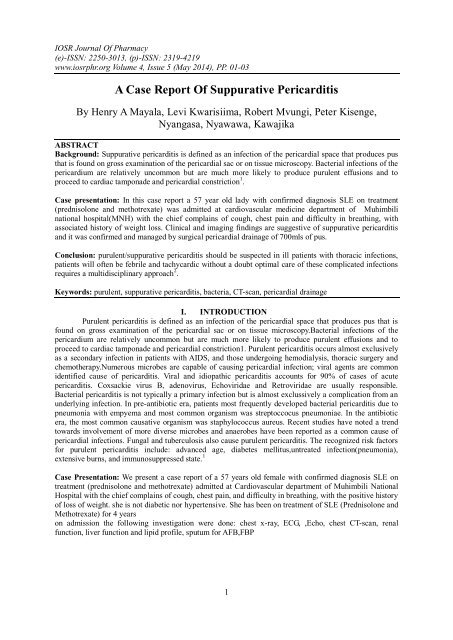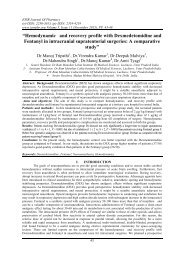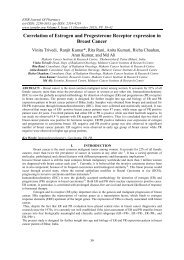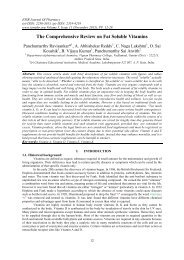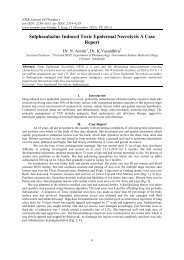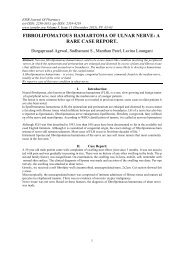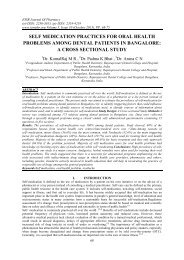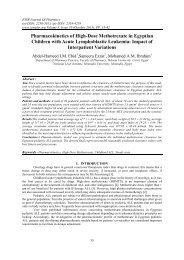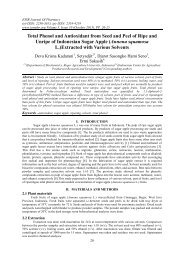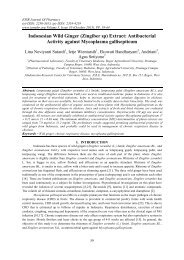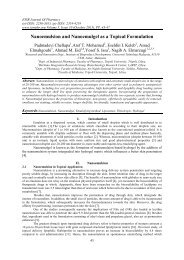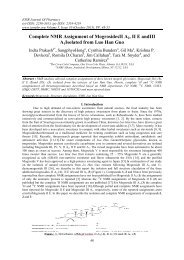A Case Report Of Suppurative Pericarditis
You also want an ePaper? Increase the reach of your titles
YUMPU automatically turns print PDFs into web optimized ePapers that Google loves.
IOSR Journal <strong>Of</strong> Pharmacy<br />
(e)-ISSN: 2250-3013, (p)-ISSN: 2319-4219<br />
www.iosrphr.org Volume 4, Issue 5 (May 2014), PP. 01-03<br />
A <strong>Case</strong> <strong>Report</strong> <strong>Of</strong> <strong>Suppurative</strong> <strong>Pericarditis</strong><br />
By Henry A Mayala, Levi Kwarisiima, Robert Mvungi, Peter Kisenge,<br />
Nyangasa, Nyawawa, Kawajika<br />
ABSTRACT<br />
Background: <strong>Suppurative</strong> pericarditis is defined as an infection of the pericardial space that produces pus<br />
that is found on gross examination of the pericardial sac or on tissue microscopy. Bacterial infections of the<br />
pericardium are relatively uncommon but are much more likely to produce purulent effusions and to<br />
proceed to cardiac tamponade and pericardial constriction 1 .<br />
<strong>Case</strong> presentation: In this case report a 57 year old lady with confirmed diagnosis SLE on treatment<br />
(prednisolone and methotrexate) was admitted at cardiovascular medicine department of Muhimbili<br />
national hospital(MNH) with the chief complains of cough, chest pain and difficulty in breathing, with<br />
associated history of weight loss. Clinical and imaging findings are suggestive of suppurative pericarditis<br />
and it was confirmed and managed by surgical pericardial drainage of 700mls of pus.<br />
Conclusion: purulent/suppurative pericarditis should be suspected in ill patients with thoracic infections,<br />
patients will often be febrile and tachycardic without a doubt optimal care of these complicated infections<br />
requires a multidisciplinary approach 2 .<br />
Keywords: purulent, suppurative pericarditis, bacteria, CT-scan, pericardial drainage<br />
I. INTRODUCTION<br />
Purulent pericarditis is defined as an infection of the pericardial space that produces pus that is<br />
found on gross examination of the pericardial sac or on tissue microscopy.Bacterial infections of the<br />
pericardium are relatively uncommon but are much more likely to produce purulent effusions and to<br />
proceed to cardiac tamponade and pericardial constriction1. Purulent pericarditis occurs almost exclusively<br />
as a secondary infection in patients with AIDS, and those undergoing hemodialysis, thoracic surgery and<br />
chemotherapy.Numerous microbes are capable of causing pericardial infection; viral agents are common<br />
identified cause of pericarditis. Viral and idiopathic pericarditis accounts for 90% of cases of acute<br />
pericarditis. Coxsackie virus B, adenovirus, Echoviridae and Retroviridae are usually responsible.<br />
Bacterial pericarditis is not typically a primary infection but is almost exclussively a complication from an<br />
underlying infection. In pre-antibiotic era, patients most frequently developed bacterial pericarditis due to<br />
pneumonia with empyema and most common organism was streptoccocus pneumoniae. In the antibiotic<br />
era, the most common causative organism was staphylococcus aureus. Recent studies have noted a trend<br />
towards involvement of more diverse microbes and anaerobes have been reported as a common cause of<br />
pericardial infections. Fungal and tuberculosis also cause purulent pericarditis. The recognized risk factors<br />
for purulent pericarditis include: advanced age, diabetes mellitus,untreated infection(pneumonia),<br />
extensive burns, and immunosuppressed state. 1<br />
<strong>Case</strong> Presentation: We present a case report of a 57 years old female with confirmed diagnosis SLE on<br />
treatment (prednisolone and methotrexate) admitted at Cardiovascular department of Muhimbili National<br />
Hospital with the chief complains of cough, chest pain, and difficulty in breathing, with the positive history<br />
of loss of weight. she is not diabetic nor hypertensive. She has been on treatment of SLE (Prednisolone and<br />
Methotrexate) for 4 years<br />
on admission the following investigation were done: chest x-ray, ECG, ,Echo, chest CT-scan, renal<br />
function, liver function and lipid profile, sputum for AFB,FBP<br />
1
A <strong>Case</strong> <strong>Report</strong> <strong>Of</strong> <strong>Suppurative</strong> ….<br />
FIGURE 1: A CHEST X-RAY – showing abnormal cardiac silhouette-flask shaped appearance<br />
FIGURE 2: CHEST CT-ANGIOGRAPHY- showing pericardial effusion<br />
2
A <strong>Case</strong> <strong>Report</strong> <strong>Of</strong> <strong>Suppurative</strong> ….<br />
FIGURE 4: ECG revealed non specific ST-changes and right atrial enlargement<br />
Echo revealed a swinging heart with a large pericardial effusion<br />
Renal function test, liver function test and lipid profile were normal.<br />
Pus culture – there was no growth<br />
Sputum for AFB- was negative<br />
FBP-showed leucocytopenia and anemia<br />
II. DISCUSSION:<br />
Purulent pericarditis is an infrequent, but important complication of infective illness, which if<br />
diagnosed early has a good prognosis. The incidence of the condition is probably increasing particularly in<br />
the immune-compromised group of patients. Classical symptoms and signs are often absent and a high<br />
index of awareness is required to diagnose the condition 7 . Our patient presented with some symptoms<br />
cough, chest pain and difficulty in breathing but we had to have a high index of suspicion to diagnose it<br />
with atypical ECG presentation.<br />
Thus this case report is so significant because of how it presented and managed. Our patient<br />
underwent a surgical pericardial drainage of 700mls of pus, which was successful. Currently our patient is<br />
discharged, with vital signs stable, on the following medication: Tazact and metronidazole and breathing<br />
exercise (respiratory physiotherapy).<br />
REFERENCES:<br />
[1] www.turner-white.com (hospital physician)- Jan 2008, shiber pp.9-17,45<br />
[2] Lange RA, hillis L.D. clinical practice. acute pericarditis in N Engl J Med 2005; 352:1163<br />
[3] Goodman L.J. purulent pericarditis. Curr Treat options cardiovasc Med 2000; 2:343-50<br />
[4] Spodick DH. The pericardium: a comprehensive text book. Newyork: M.bekker, 1997<br />
[5] www.emedicine.medscape.com<br />
[6] www.ncbi.nlm.nih.gov<br />
[7] Annals of surgery (Ann surg. sep 1936; 104(3): 365-372 by James Harry Heyl<br />
[8] Textbook of Mayo clinic Internnal medicine<br />
[9] Rubin RH, moelling RC, Jr.Clinical microbiological and therapeutic aspects of purulent pericarditis.<br />
AM J med. 1975 Jul:59(1):68-78. (Pubmed)<br />
3


